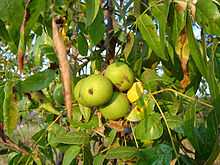Juglans californica
| Juglans californica | |
|---|---|
 | |
| California Black Walnut | |
| Conservation status | |
| Scientific classification | |
| Kingdom: | Plantae |
| (unranked): | Angiosperms |
| (unranked): | Eudicots |
| (unranked): | Rosids |
| Order: | Fagales |
| Family: | Juglandaceae |
| Genus: | Juglans |
| Section: | Rhysocaryon |
| Species: | J. californica |
| Binomial name | |
| Juglans californica S. Wats. | |
 | |
| Natural range | |
Juglans californica, the California black walnut, also called the California walnut, or the Southern California black walnut, is a large shrub or small tree (up to 30 feet tall) of the Juglandaceae (walnut) family endemic to California.
Distribution
J. californica is generally found in the southern California Coast Ranges, Transverse Ranges, and Peninsular Ranges, and the Central Valley. It grows as part of mixed woodlands, and also on slopes and in valleys wherever conditions are favorable. It is threatened by development and overgrazing. Some native stands remain in urban Los Angeles in the Santa Monica Mountains and Hollywood Hills. J. californica grows in riparian woodlands, either in single species stands or mixed with California's oaks (Quercus spp.) and cottonwoods (Populus fremontii).
Description
Juglans californica can be either a large shrub with 1-5 trunks, or a small, single-trunked tree. The main trunk can fork close to the ground, making it look like two trees that have grown together, then diverged. It has thick bark, deeply channeled or furrowed at maturity. It has large, pinnately compound leaves with 11-19 lanceolate leaflets with toothed margins and no hair in the vein angles.[2] It has a small hard nut in a shallowly grooved, thick shell that is difficult to remove.
Uses
Food
The Chumash Indians of the Channel Islands of California and Ventura County once ate the nuts; however, they are not grown commercially for this purpose.
Cultivation
J. californica is cultivated as an ornamental tree where it is planted in California native plant, xeriscape, and wildlife habitat gardens and natural landscaping in California, and in Hawaii.
Taxonomy
Some authorities (e.g. the California Native Plant Society) combine this species with J. hindsii. On the other hand, a 2007 molecular analysis of the genus[3] suggests J. californica is sister to the remaining black walnuts (Rhysocaryon). This article follows the conventions of The Jepson Manual.[4][5]
See also
References
- ↑ Essa, Lora. "Index of Species Information". U.S. Department of Agriculture, Forest Service,. Retrieved 2013.
- ↑ Kershner, Mathews, Nelson, and Spellenberg, National Wildlife Federation field Guide to Trees of North America, 2008, Chanticleer Press, Inc. p. 229
- ↑ Aradhya, M. K, D. Potter, F. Gao, & C. J. Simon: "Molecular phylogeny of Juglans (Juglandaceae): a biogeographic perspective: Tree Genetics & Genomes (2007)3:363-378
- ↑ Juglans californica S. Watson var. hindsii Jeps.
- ↑ Juglans hindsii Jeps. ex R. E. Sm.
Further reading
- Hickman, James C., ed. The Jepson Manual: Higher Plants of California. University of California Press. 1993.
- Anderson, E. N. "Some preliminary observations on the California black walnut (Juglans californica)" in Fremontia: A Journal of the California Native Plant Society. January 2002.
External links
| Wikimedia Commons has media related to Juglans californica. |
| External identifiers for Juglans californica | |
|---|---|
| Encyclopedia of Life | 1247247 |
| ITIS | 19249 |
| NCBI | 91212 |
| Also found in: Wikispecies | |
- Jepson Manual Treatment - Juglans californica
- USDA Plants Profile: - ″Juglans californica″
- Ecology
- Juglans californica - U.C. Photo gallery
- Interactive Distribution Map for Juglans californica
